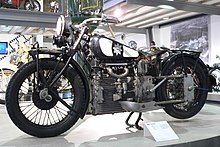Windhoff (Berlin)

Windhoff was a German company based in Berlin that built coolers, petrol tanks and, from 1924, motorcycles.
The company's founder , Hans Windhoff, was the managing director of Gebrüder Windhoff GmbH - engine, vehicle and machine factory until 1907 , where he left the company and initially founded Hans Windhoff Apparate- und Maschinenfabrik AG in Berlin Schöneberg ( Bülowstraße ) in order to produce coolers based on his patents on his own to produce. They were used in motor vehicles , but also in airplanes .
At the beginning of the 1920s, Windhoff began developing a two-stroke motorcycle , for which he founded Windhoff Motorenbau GmbH . The company first moved to Johannisthal and operated under the name of Hans Windhoff Motorenbau , later to Berlin-Friedenau .
The Windhoff engine was a water-cooled horizontal single cylinder. The cylinder was part of the radiator. The performance was increased by a charge pump . It was based on the development of the Bekamo engine by Hugo Ruppe . These motorcycles were manufactured from 1924.
At the Avus race in May 1925, Windhoff won the first two places in the class up to 125 cm². The success was repeated in September of the same year. In addition, a double victory was achieved in the 175 cm² class. These two motorcycles went into series production and initially sold very well. In a 24-hour race on the Opel racetrack in 1928 , two world records were set for the 125 cc class. The 1000 km were covered with an average of 61.2 km / h. The distance achieved with 1451 km in 24 hours was also a world record. However, enlarged 493 cc and 517 cc models were found to be impractical.
Despite the sporting successes, sales fell. Windhoff began developing large-volume four - stroke models . In 1927, at the Berlin trade fair, he presented a motorcycle with a leaf spring front fork, a 4-cylinder in-line engine with 748 cm³ displacement and 22 hp, of which around 250 were manufactured by 1931 at a basic price of 1750 Reichsmarks. The engine had an overhead camshaft and bucket tappets and was liquid-cooled with 6.5 liters of oil as coolant. The special thing about this motorcycle was that there was no frame in the usual sense, but that the gearbox and the subframe were bolted to the engine. (Patent 463399 Motorcycle with the engine as a support part between the front and rear wheel , registered December 14, 1926, issued July 12, 1928) The foot-operated brake acted on the cardan shaft.
In 1929 a two-cylinder boxer with 999 cc and SV control was added; the “chassis” corresponded to the four-cylinder model, but the foot brake was designed as a block brake. The motorcycle was similar to the BMW boxers of the time. In the same year, work began on a new motorcycle that was to be equipped with a 175 cm³ Villiers engine. The license negotiations were unsuccessful. Instead, Kurt Pohle was commissioned to develop two simple air-cooled single-cylinder two-stroke engines with 198 cm³ and 298 cm³ with nose pistons based on the Villiers engine. However, there was no significant production and Windhoff gave up motorcycle production in 1931. The cooler production continued until at least 1952.
literature
- Motorcycle Classic 4/89
- Erwin Tragatsch : All motorcycles - 1894 until today , Motorbuch Verlag, 5th edition 1982
- Siegfried Rauch; Frank Rönicke: Men and motorcycles - a century of German motorcycle development. Stuttgart: Motorbuch-Verlag 2008, ISBN 978-3-613-02947-7 , pp. 230–241
